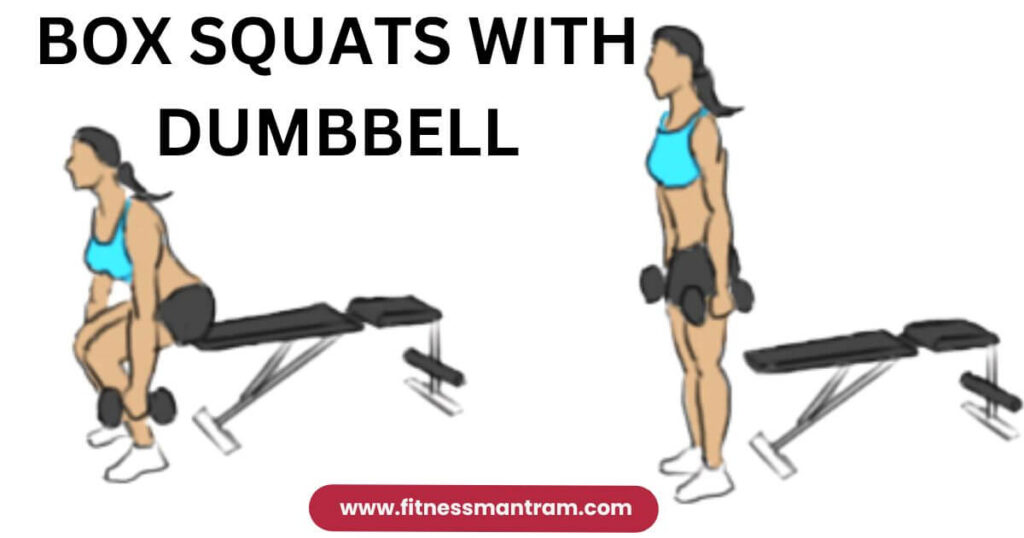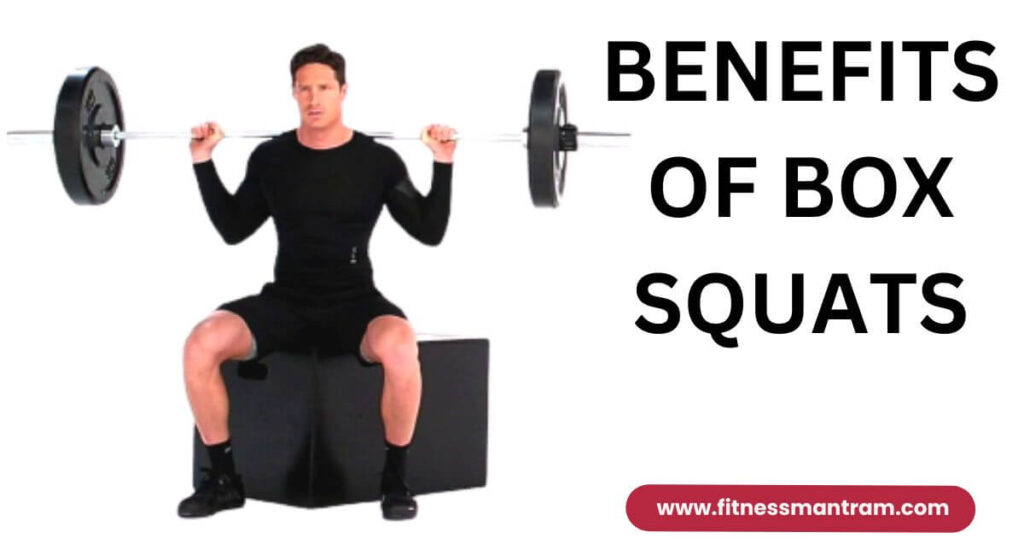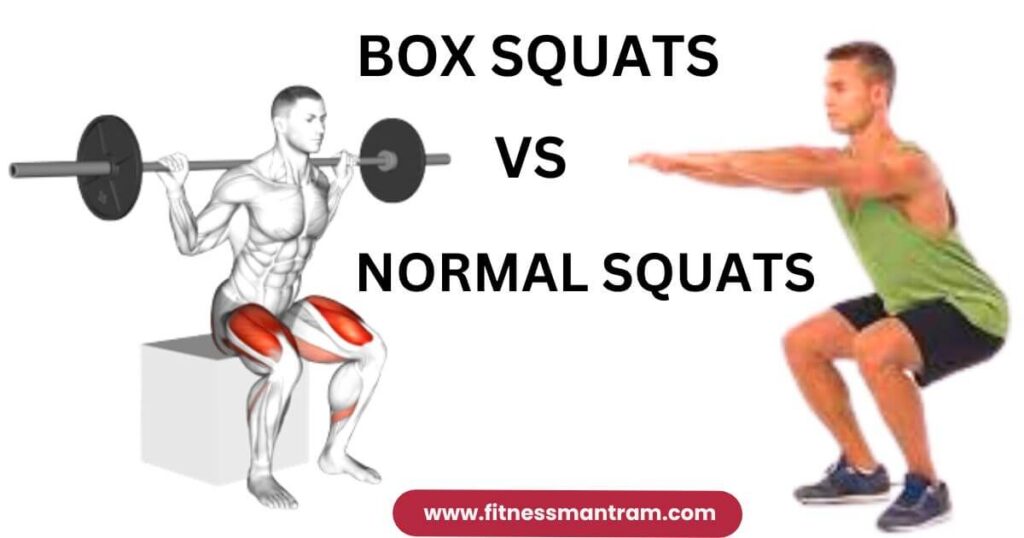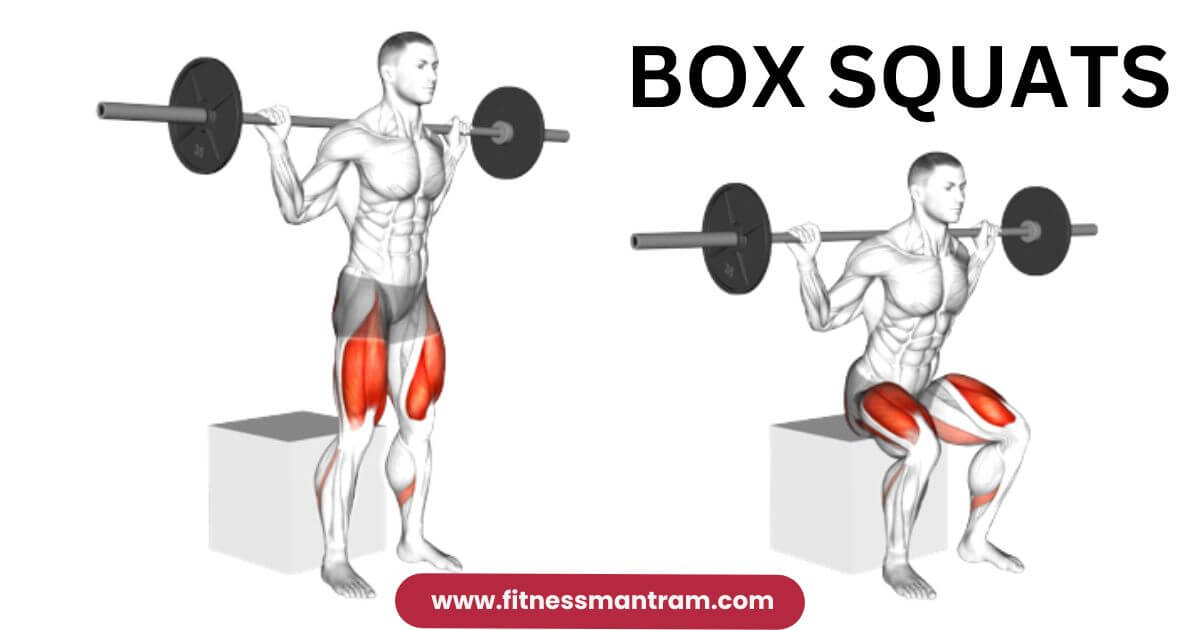Introduction
Hello Friends, In this article we we learn How To Do Box Squats Like A Professional. Basically box squats are a type of squat exercise that involves sitting back on a bench or box, pausing for a moment, and then getting up. This exercise, which is a twist on the standard squat, is frequently used in strength and powerlifting programs to improve lower-body strength and explosiveness.
You will need a sturdy box or bench that is about knee height when you are standing next to it to perform a box squat. The steps are as follows:
1.With your toes slightly pointing outward and your feet shoulder-width apart, stand in front of the box.
2.Grip the barbell with both hands and place it across your upper back, just below your neck.
3.Breathe deeply and strengthen your core.
4.Sit back up on the box, putting your weight on your heels and keeping your knees behind your toes.
5.After a brief pause on the box, drive through your heels and stand up while carrying the barbell.
6.Repeat as many times as you like.
What Are Box Squats Good For?
Box squats are a versatile exercise that can help a person achieve a variety of goals, depending on how they are done and what they want to accomplish. Box squats may provide the following potential advantages:
- Building Muscle: Box squats can help strengthen the quadriceps, hamstrings, and glutes in the lower body. You can challenge your muscles and encourage growth and adaptation by training with heavy weights and low repetitions.
- Explosiveness Enhancement: Box squats can aid in the development of explosive power in the lower body by sitting back onto a box and then exploding up. Athletes in sports that require jumping, running, or other explosive movements may benefit from this.
- Forming The Squat Better: Box squats can help people learn how to squat correctly by sitting back onto a box. Proper form includes keeping the knees behind the toes and maintaining a neutral spine. People who have mobility issues or struggle with proper squat form may benefit from this.
- Taking Pressure Off The Knees: Due to the fact that they place less stress on the knees than traditional squats do, box squats can be beneficial for people with knee issues. Sitting back onto a box places less stress on the knees, which can help some people feel less pain or discomfort.
- Strengthening The Core: Box squats can also be hard on the core because you have to brace your core to keep your form while doing them. The stability and overall strength of the core may benefit from this.
Box Squats With Dumbbells
When using dumbbells for box squats, it’s important to keep your form and technique correct. Throughout the exercise, keep your knees behind your toes, back straight, and chest up. If this is your first time doing this exercise, start with a lighter weight and increase it gradually as you get more used to the movement. To challenge your muscles in a variety of ways, you can also try different box heights.

Doing box squats with dumbbells can help you improve your balance and stability while also providing an additional challenge. Perform box squats with dumbbells in the following order:
1.With your palms facing inward, hold a pair of dumbbells at your sides.
2.With your toes slightly pointing outward and your feet shoulder-width apart, stand in front of the box.
3.Grip the dumbbells tightly by placing them across your upper back, just below your neck.
4.Breathe deeply and strengthen your core.
5.Sit back up on the box, putting your weight on your heels and keeping your knees behind your toes.
6.After a brief pause on the box, drive through your heels and stand up while simultaneously lifting the dumbbells.
7.Repeat as many times as you like.
Benefits Of Box Squats
Box squats are an adaptable exercise that can offer a variety of advantages, including:
1.Improving Explosiveness : By making you work harder to stand up from the box, box squats can help you build explosive power in your lower body. Athletes in sports that require jumping, running, or other explosive movements may benefit from this.

2.Building Strength : Box squats are a compound exercise that can help strengthen the quadriceps, hamstrings, and glutes in the lower body. You can challenge your muscles and encourage growth and adaptation by using heavy weights and low repetitions.
3.Forming The Squat Better: Box squats can teach people how to squat correctly by keeping the knees behind the toes, keeping the spine neutral, and using the right muscles. People who have mobility issues or struggle with proper squat form may benefit from this.
4.Reducing stress on the knees : Due to the fact that they place less stress on the knees than traditional squats do, box squats can be beneficial for people with knee issues. Sitting back onto a box places less stress on the knees, which can help some people feel less pain or discomfort.
5.Developing Balance and Stability: You can perform box squats with a variety of box heights and equipment, which can test your balance and stability. Your overall coordination and body awareness may benefit from this.
6.Developing the core: Box squats can also be hard on the core because you have to brace your core to keep your form while doing them. The stability and overall strength of the core may benefit from this.
Are Box Squats As Good As Regular Squats?
Regular squats and box squats are both good exercises for building strength in the lower body. However, there are some differences between them that may make one better for you than the other, depending on your goals and needs.
Typically, box squats are performed by sitting back onto a bench or box and rising again. Because it emphasizes sitting back and loading the hips prior to standing up, this variation can be helpful for both teaching proper squat form and developing explosive power.
Because the box helps control the depth of the squat and reduces the amount of stress placed on the knee joint, box squats can also be easier on the knees.
Regular squats, on the other hand, involve descending into a full squat and rising again. Because it requires a greater range of motion and more stabilization, this variation may be more challenging for developing lower body strength. To perform regular squats safely and effectively, you also need to have good mobility and flexibility.
Therefore, are box squats equivalent to regular squats? It depends on your requirements and goals. Box squats might be a good choice for you if you want to build explosive power, improve your squat form, or ease knee pain.
Regular squats might be a better choice if you want to improve your mobility and overall strength in the lower body. In either case, proper form and technique are essential, and the exercise’s weight and intensity should be gradually increased over time.
Box Squats vs Normal Squats
Box squats and normal squats are both variations of the squat exercise that target the muscles of the lower body. However, there are a number of ways in which they differ from one another.

The Squat’s Depth: While in a box squat, you sit back onto a bench or box and then stand back up, in a normal squat, you descend as low as possible until your hips are below your knees. Because it emphasizes sitting back and loading the hips prior to standing up, this variation can be helpful for both teaching proper squat form and developing explosive power.
Because the box helps control the depth of the squat and reduces the amount of stress placed on the knee joint, box squats can also be easier on the knees.
Stabilization: In a box squat, you have a brief pause and a change in direction at the bottom, which can make the exercise feel different. In a normal squat, you have to stabilize the weight throughout the entire range of motion. People who have mobility issues or struggle with proper squat form may benefit from this.
Focused On Muscles : The glutes, hamstrings, and quadriceps are the primary lower body muscles that are targeted in both normal and box squats. Box squats, on the other hand, may focus more on the muscles of the posterior chain (glutes and hamstrings) than normal squats do, which may focus more on the quadriceps.
Required Equipment: Box squats require a box or bench, whereas a normal squat only requires a barbell and weights.
Which One Is Superior Then?
It depends on your requirements and goals. Both exercises have distinct advantages and have the potential to build strength and muscle mass in the lower body. Box squats might be a good choice if you want to teach proper squat form or build explosive power. Normal squats might be a better choice if you’re looking for a more conventional squat exercise that targets the entire range of motion. Any exercise should always be performed with proper form and technique, and the weight and intensity should be gradually increased over time.
Are Box Squats Good For Athletes?
Athletes can benefit greatly from including box squats in their training regimen. However, as with any exercise, proper form and technique are essential, and the weight and intensity should be gradually increased over time. When making a training plan, it’s also important to think about the athlete’s specific wants and needs.
Box squats can help athletes train. The reasons for this include:
1.Potency To Explode: By making you work harder to stand up from the box, box squats can help you build explosive power in your lower body. Athletes in sports that require jumping, running, or other explosive movements may benefit from this.
2.Less Strain Placed On The Knees: Due to the fact that they place less stress on the knees than traditional squats do, box squats can be a good choice for athletes with knee problems. Sitting back onto a box places less stress on the knees, which can help some people feel less pain or discomfort.
3.Modified Form: Athletes can improve their squat form by focusing on sitting back and loading the hips before standing up during box squats. This can assist in the formation of proper movement patterns, which can be applied to various sports and exercise movements.
4.Developing The Core: Box squats can be hard on the core muscles because athletes need to brace their core to keep their form correct. The stability and overall strength of the core, which are crucial for many sports movements, may benefit from this.
5.Customizable: Box squats can be performed with a variety of box heights and equipment, which can be adjusted to meet the requirements and objectives of each athlete. Athletes may be able to modify the exercise to target specific sports movements or particular regions of their lower body as a result of this.
Benefits Of Box Squats For Athletes
Box squatting can have a number of advantages for athletes. The following are some major advantages:
Posterior Chain Strengthening: The muscles of the posterior chain, such as the hamstrings and glutes, can be strengthened with box squats. Sports movements like jumping, accelerating, and decelerating require these muscles. Athletes with strong posterior chain muscles can run faster, jump higher, and move with more force.
Improved Explosiveness: Box squats can help athletes build explosive leg power, which is necessary for many sports movements like sprinting, jumping, and changing directions. Athletes who sit back onto a box need to generate more power to stand up, which can help them become more explosive.
Strengthening The Core: Box squats test core muscles because athletes must brace their core to keep their form throughout the exercise. The stability and overall strength of the core, which are crucial for many sports movements, may benefit from this.
Less Strain Placed On The Knees: Box squats can be a good exercise for athletes with pain or problems in their knees. When compared to standard squats, sitting back onto a box places less stress on the knees, which can help improve knee health.
Improved Squat Technique: Athletes can improve their squat form by focusing on sitting back and loading the hips before standing up during box squats. This can assist in the formation of proper movement patterns, which can be applied to various sports and exercise movements.
Which Squats Are Hardest?
The individual’s strength, flexibility, and body mechanics all play a role in how they respond to this question. However, there are a few different kinds of squats that are frequently regarded as being more difficult than others:
In the end, a person’s fitness level, body mechanics, and training experience may all influence the difficulty of a particular variation of the squat. In order to avoid injury, it is essential to work with a certified trainer to ensure that you are using proper form and technique and progress gradually.
Squat Pauses: Pause squats involve standing up after pausing at the bottom of the squat. While some people may find it more difficult to maintain the bottom position as a result, this can help them improve their technique and strength.
Back Squats: As the weight is held in front of the body, front squats require more upper body strength and mobility than back squats do. For some people, this may make front squats more difficult.
Squats With A Gun: Pistol squats are a variation of the single-leg squat that requires a great deal of strength and balance. They can be especially difficult for people who have limited mobility in their hips, knees, or ankles.
Squats Overhead: An advanced variation of the squat, overhead squats require core strength and stability in addition to significant mobility in the hip, thoracic spine, and shoulders. While lifting a weight overhead, maintaining proper form can be challenging.
Do Box Squats Build Big Legs?
Box squats have the potential to increase leg strength and size, but whether or not they result in “big” legs depends on a number of factors, including genetics, diet, and overall training program.
Box squats can help you build strength and power in your lower body, especially your glutes, hamstrings, and quadriceps. Compared to traditional squats, standing up and sitting back onto a box emphasizes the hips and posterior chain muscles more. In these areas, this may aid in the growth of muscle mass and strength.
But if you want “big” legs, you’ll also need to work on other exercises and things like:
Diet: Good nutrition is also necessary for muscle building. To help muscle growth, you need to eat enough calories and protein. Healthy fats, complex carbohydrates, and lean protein are all necessary components of a well-balanced diet.
Overloading In Stages: To build muscle, you need to work your muscles by lifting weights that get heavier over time. To continue gaining muscle mass, you may need to gradually increase the weight you use for the box squat or include additional exercises in your training plan.
Program Overall For Training: Lunges, leg presses, and deadlifts are just a few of the lower-body exercises you’ll need to do in order to get “big” legs. You might also need to incorporate exercises that work the calves and other leg muscle groups.
Although box squats can help build strength and muscle mass in the lower body, whether or not they result in “big” legs will depend on a number of other factors.
Conclusion
In conclusion, box squats can be a useful exercise for improving squat form, strengthening the posterior chain, building lower body strength and power, increasing explosiveness, reducing knee stress, and strengthening the lower body. Box squats may also be a good choice for athletes who have pain or problems in their knees. However, a number of factors, including genetics, diet, and the overall training program, will determine whether or not box squats result in “big” legs. You will also need to focus on other exercises and factors like progressive overload, proper nutrition, and a well-rounded training program that targets all of the major muscle groups in the legs in order to build muscle mass in the legs.
Frequently Asked Questions
How does a box squat work?
A variation of the standard barbell squat, the box squat requires the lifter to sit back onto a bench or box and then stand up again.
How do you perform a box squat?
Set up a box or bench that is about knee height before beginning the box squat exercise. After that, with the bar on your back, you walk toward the box, step back, and stand with your feet shoulder-width apart. Stand up after a brief pause before sitting back down on the box.
What muscles are engaged in box squats?
The glutes, hamstrings, and quadriceps, as well as the core and lower back, are the primary muscles that are engaged in box squats. Additionally, they have the potential to ease knee stress and improve hip mobility.
What advantages do box squats offer?
Box squats can improve squat form and technique, reduce knee stress, strengthen the posterior chain, and help build strength and power in the lower body.
How do box squats compare to regular squats?
Box squats can be a good choice for athletes with knee pain or problems because they put more emphasis on the hips and posterior chain muscles than traditional squats do. However, regular squats may be more beneficial for increasing muscle mass and strength throughout the lower body.
Are box squats a good exercise for explosive movements?
Yes, strengthening and power in the lower body can be increased through box squats, which can help improve explosive movements like sprinting and jumping.
Are box squats suitable for beginners?
Box squats can be a good exercise for beginners, but it’s important to start with a lighter weight and use good form. Working with a trained instructor is also a good idea to make sure you are using the right form and technique.
Read More
- Hindu Squats: Hindu Squats vs Normal Squats
- Types of yoga practice and benefits
- 10 Basic Tips to get Body in Shape
- Importance of A Healthy Diet and Exercise
- Forbidden Weight loss Secrets
Disclaimer : The details & information given here in this article is based on information as available on other published site on internet. Do take medical advice before adopting it. Fitness Mantram Does Not Confirm It. This site contains affiliate links. If you choose to make a purchase after clicking a link the author/owner/creator may receive a commission at no ADDITIONAL cost to you. Thank you for your support!

1 thought on “Box Squats- How To Do Box Squats Like A Professional”